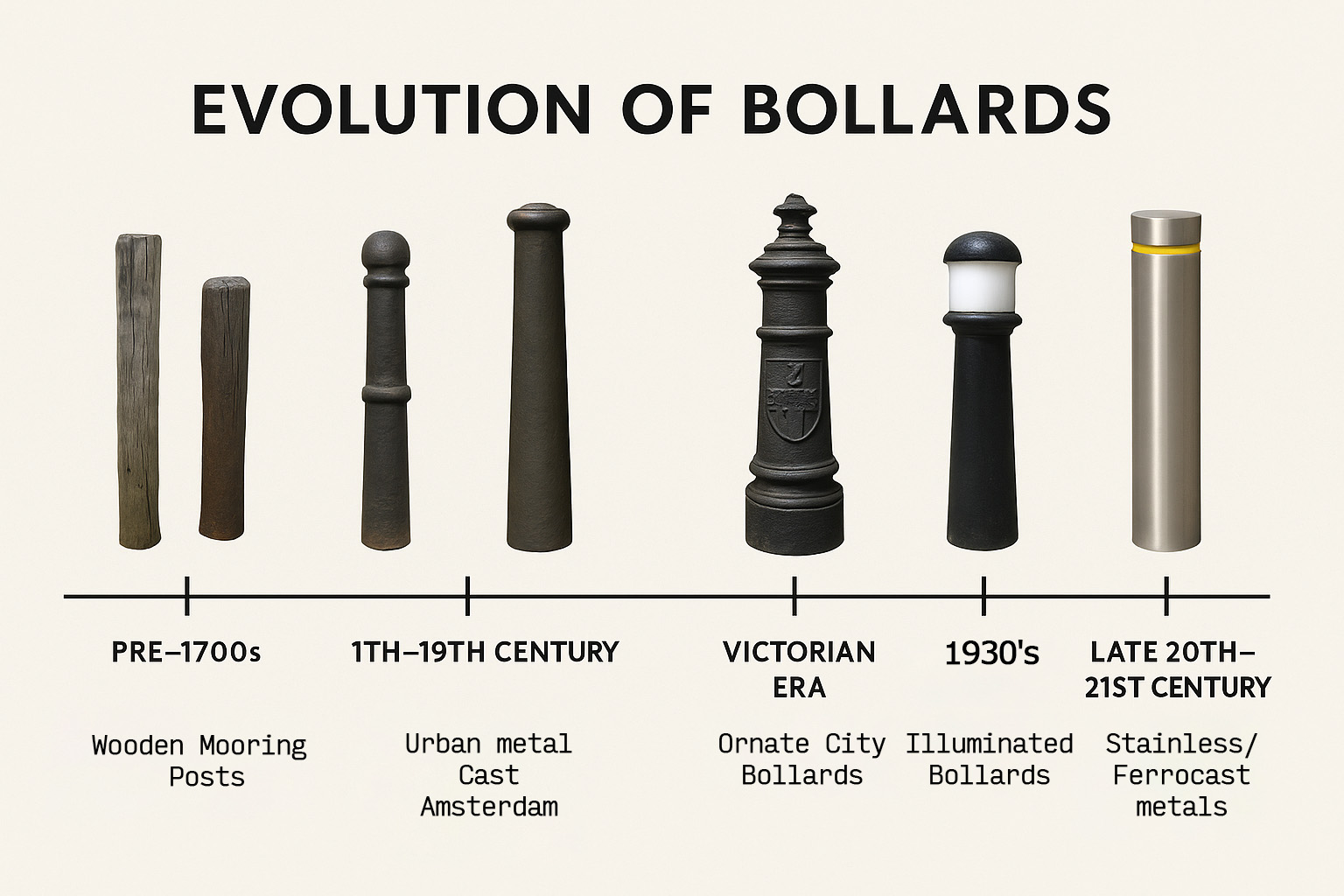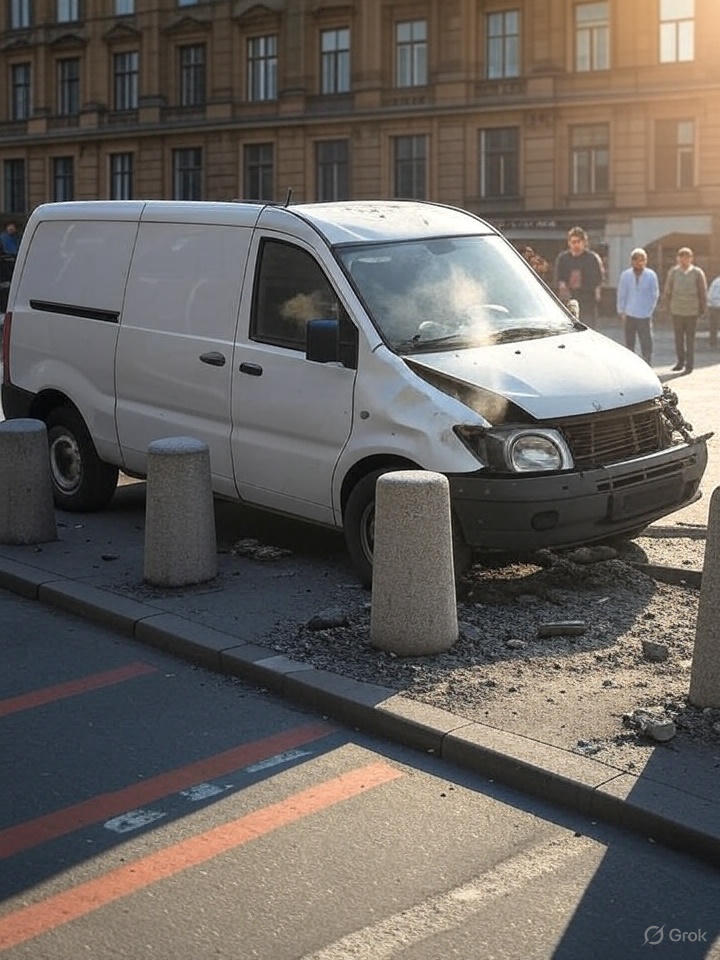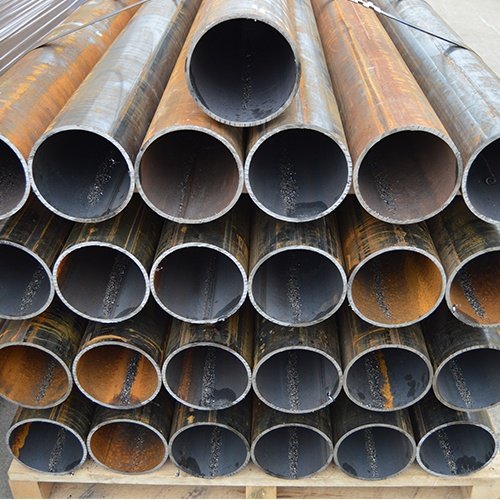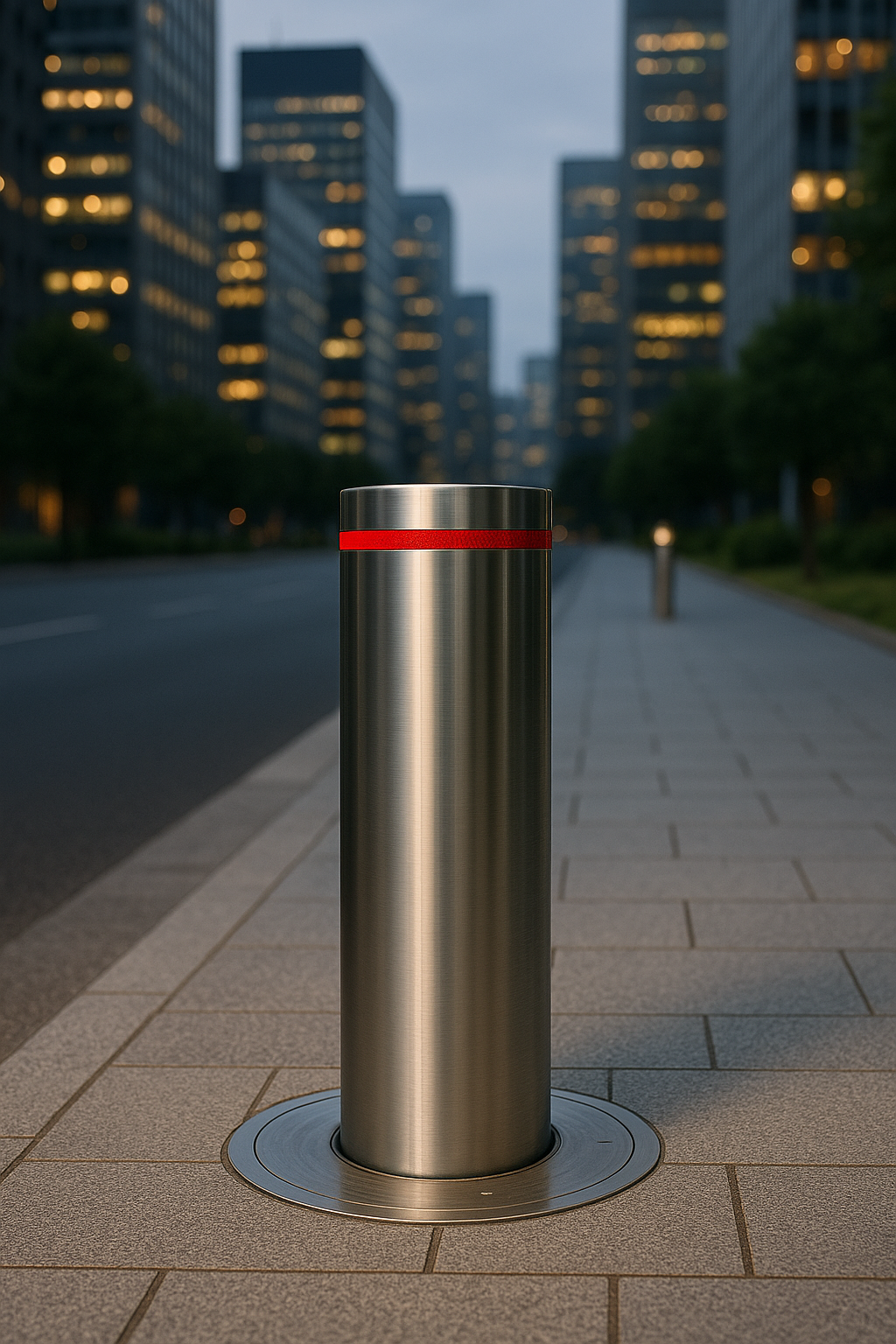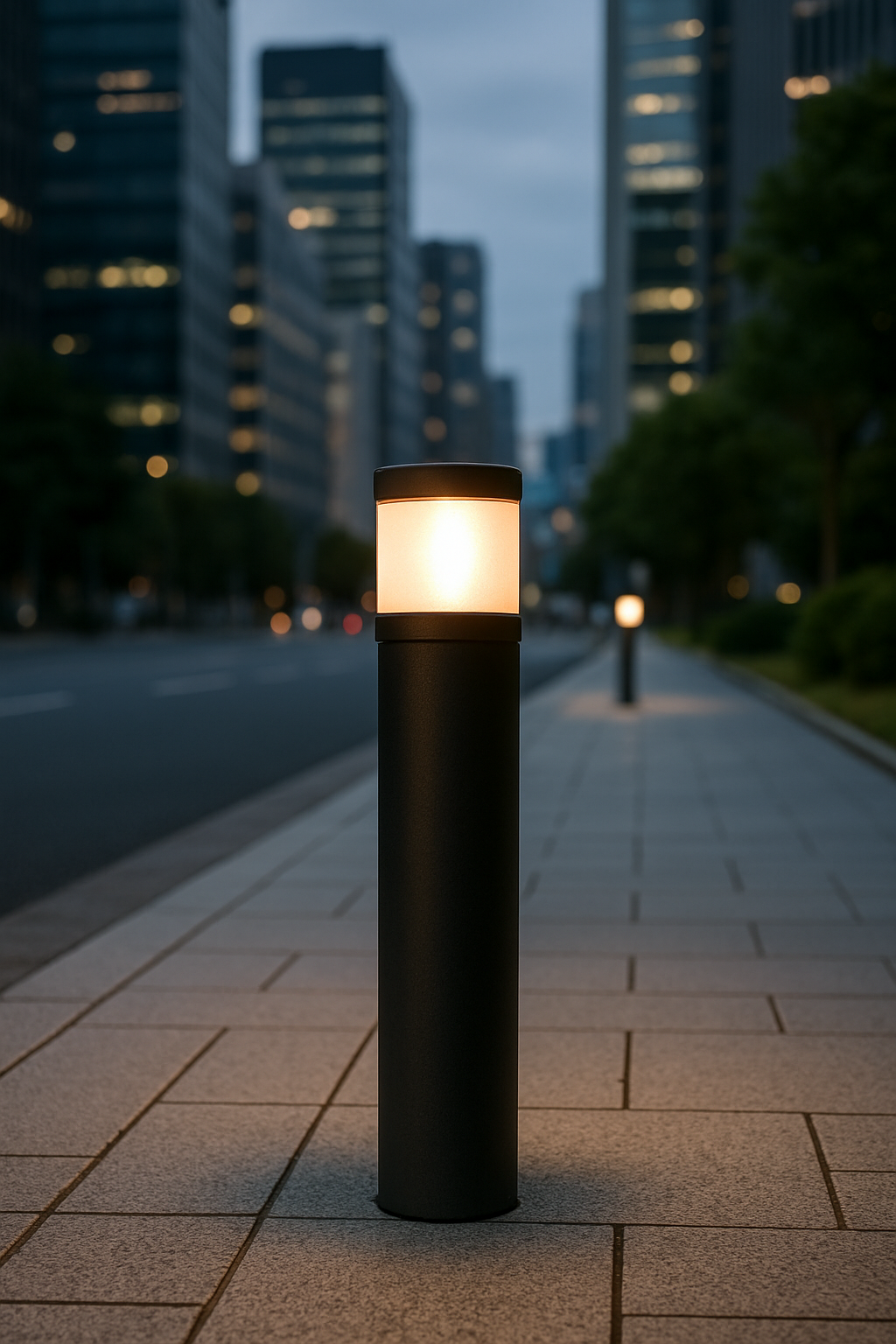As cities continue to evolve, bollards will likely incorporate even more advanced features, ensuring safe, efficient, and aesthetically pleasing public spaces.
The Evolution of Bollards: From Maritime Mooring to Secure Traffic Control
Introduction
Bollards are short, sturdy vertical posts that serve a variety of purposes in modern society, from directing traffic and protecting pedestrians to enhancing urban aesthetics and providing high-level security against vehicular threats. The term “bollard” likely derives from the Old Norse word “bole,” meaning tree trunk, reflecting their early origins as simple, robust structures. Over centuries, bollards have transformed from nautical mooring devices to essential tools in urban planning and security. This evolution mirrors broader societal changes, including urbanization, industrialization, and the rise of motorized vehicles and security concerns. Today, bollards are engineered with advanced materials and technologies, such as crash-rated designs capable of withstanding high-impact collisions, making them indispensable in protecting public spaces from accidental or intentional vehicle intrusions.
This article explores the history of bollards, tracing their origins in maritime settings through their adaptation for traffic management and eventual role in secure traffic control. A detailed timeline is provided to highlight key milestones in their development.
Origins and Early History
The story of bollards begins in ancient maritime environments, where they served as mooring posts to secure ships at docks and quaysides. These early bollards were designed to withstand the forces of ocean currents and waves, ensuring vessels remained stable during loading, unloading, or adverse weather. Initially crafted from readily available materials like wood or stone, they provided a practical solution for maritime trade and navigation.
By the 17th and 18th centuries, bollards had become more standardized in maritime use. They were typically wooden or iron posts installed on ships or quaysides, around which ropes were wrapped to moor vessels securely. A notable innovation during this period was the repurposing of decommissioned cannons as bollards. These were buried muzzle-first into the ground, with the exposed breech end providing a strong anchor point for ropes. This practice was common in regions like the British Isles, Nova Scotia, and Cuba, leveraging the cannons’ durability and availability after wars. The design often included a wider top or cannonball cap to prevent ropes from slipping, emphasizing functionality in harsh marine conditions.
Transition to Urban and Traffic Use
As urbanization accelerated in the 18th century, bollards began to migrate from docks to city streets. Wooden posts were installed in towns and villages across England to control traffic, protect pedestrians, and safeguard buildings from horse-drawn carriages. This marked the initial shift toward land-based applications, where bollards served as barriers to guide vehicles and prevent collisions in increasingly crowded urban areas.
In the early 1800s, cities like Amsterdam introduced decorative cast-iron bollards, known as “Amsterdammertje,” to shield buildings in narrow, curb-less streets from carriage damage. This period also saw bollards blending functionality with aesthetics, as urban planners recognized their potential to enhance cityscapes while maintaining safety.
Industrial Revolution and Material Innovations
The 19th century, fueled by the Industrial Revolution, brought significant advancements in bollard design and materials. Cast iron emerged as the preferred material due to its durability, corrosion resistance, and ease of mass production. Cities such as London, Paris, and New York adopted these bollards widely to manage the surge in traffic from industrialization. Many retained the cannon shape as a nod to their maritime heritage, but ornate designs became common, incorporating civic symbols like coats of arms.
Engineers like William Haywood in London promoted elaborate cast-iron bollards painted in distinctive colors, symbolizing civic identity. An ingenious example from 1886 was a hollow bollard in London’s Idol Lane that doubled as a ventilation system for a public urinal, illustrating creative urban integration. As horse-drawn carriages gave way to motor vehicles, materials shifted further toward iron and steel to withstand heavier impacts.
20th Century Developments: Lighting and Recognition
The 20th century introduced illuminated bollards, first appearing in the 1930s in the United Kingdom and Ireland to improve nighttime visibility. These featured recessed lighting to endure vehicle collisions and served as alternatives to streetlights, enhancing traffic guidance. Post-World War II, bollards were initially viewed as street clutter, but their value for pedestrian safety was reaffirmed.
By the 1980s, heritage-focused urban renewal projects, such as those in London, reinstated decorative bollards. Materials diversified to include concrete for heavy-duty applications and bronze for aesthetics. Flexible and removable designs emerged, allowing for adaptable traffic management in multi-use spaces.
Modern Security Applications
In the late 20th and 21st centuries, bollards evolved into sophisticated security devices in response to rising threats like vehicle-ramming attacks and ram-raiding. Crash-rated bollards, tested against standards such as ASTM F2656 and PAS 68, became standard for protecting high-risk sites like embassies, stadiums, airports, and government buildings. Hydraulic and retractable models, often made from 316 stainless steel, allow controlled access while providing robust barriers.
Smart bollards integrated with sensors, AI, and solar power now monitor traffic, crowds, and security risks, reflecting sustainable and technological advancements. Eco-friendly materials, such as bio-polymers from sugar cane, address environmental concerns. Today, bollards balance security with design, customizing to fit cultural and architectural contexts worldwide.
Timeline of Bollard Evolution
The following table outlines key milestones in the history of bollards, focusing on their transition to secure traffic control:
| Period/Date | Event/Development | Materials | Purpose/Evolution |
|---|---|---|---|
| Pre-17th Century | Origins as mooring posts from Old Norse “bole” (tree trunk). | Wood, Stone | Maritime mooring for ships. |
| 17th-18th Centuries | Wooden/iron posts for mooring; cannon bollards repurposed from decommissioned artillery. | Wood, Iron, Cannons | Securing vessels; early urban protection in cities like Amsterdam. |
| 1721 | Oak posts installed in Waltham Cross, Hertfordshire, to protect Eleanor Cross from carriages. | Wood | First documented land-based traffic control. |
| Early 1800s | “Amsterdammertje” cast-iron bollards in Amsterdam for building protection. | Cast Iron | Traffic management in urban streets. |
| 1844 | Term “bollard” appears in Oxford English Dictionary. | N/A | Formal recognition of the term. |
| 1867 | Defined in Sailor’s Word-Book as a whale-boat post. | Wood | Continued maritime emphasis. |
| 19th Century | Industrial Revolution: Cast-iron bollards widespread; ornate designs in London. | Cast Iron, Steel | Pedestrian safety and traffic control amid urbanization. |
| 1886 | Hollow bollard in London’s Idol Lane for urinal ventilation. | Cast Iron | Multifunctional urban design. |
| 1930s | Illuminated bollards introduced in UK/Ireland for visibility. | Metal with Lighting | Nighttime traffic guidance. |
| 1948 | Term officially refers to traffic control products. | Various | Shift to modern urban applications. |
| Post-WWII | Initially seen as clutter; later valued for safety. | Concrete, Metal | Pedestrian protection revival. |
| 1980s | Reinstated in London for heritage projects. | Cast Iron, Decorative | Aesthetic and historical integration. |
| 2005 | Crash-rated bollards at Goldman Sachs HQ in London. | Steel, Hydraulic | High-security against vehicle threats. |
| 21st Century | Smart, retractable, and eco-friendly bollards; crash-rated standards. | Stainless Steel, Bio-polymers, Concrete | Secure traffic control, anti-ram protection, smart city integration. |
Conclusion
From humble maritime beginnings to cutting-edge security solutions, bollards exemplify how everyday infrastructure adapts to societal needs. Their journey underscores innovations in materials, design, and functionality, driven by urbanization, technology, and security imperatives. As cities continue to evolve, bollards will likely incorporate even more advanced features, ensuring safe, efficient, and aesthetically pleasing public spaces.


